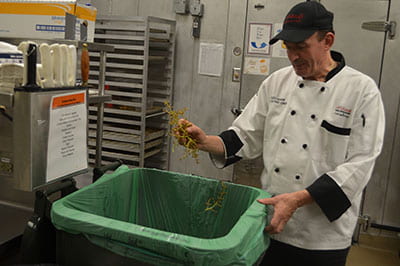High-energy leftovers: Scraps find a taker at neighbor campus
 Behind the scenes at the University Union’s kitchen operated by A’viands Food and Services Management, there’s a lot of fancy knife work going on. Cutting, chopping, slicing, dicing, and paring is a part of the everyday work that helps feed several thousand people daily at various UW-Green Bay dining venues.
Behind the scenes at the University Union’s kitchen operated by A’viands Food and Services Management, there’s a lot of fancy knife work going on. Cutting, chopping, slicing, dicing, and paring is a part of the everyday work that helps feed several thousand people daily at various UW-Green Bay dining venues.
But where do the parts that get cut, chopped or sliced off in preparing your food end up?
Until mid-September, those “pre-consumer” scraps went to the landfill where they became part of the more than 36 million tons of food waste generated annually in this country, contributing to the production of methane gas, a potent greenhouse gas when released to the atmosphere.
Now, the Union and A’viands team is collecting the scraps from daily food preparation and shipping those leftovers 50 miles down the road to UW-Oshkosh, which has an industrial-scale dry fermentation anaerobic biodigester.
That’s a really long name for a process that allows the waste food to do its thing — decay (ferment) without air (anaerobic) through use of microbes (the real biodigesters) which produce methane as one of the by-products. The methane gas is collected from the “fermentation vessels” of the digester in a bag house, which is basically a highly specialized balloon that expands as the methane fills it. The methane gas is then burned in a combined heat and power engine that has the capacity to produce 370kW of electricity and 495 kW of heat. What remains after the 28 days of fermentation is something called digestate, which can be used as compost.
UWO estimates the plant will provide up to 10% of its electricity when the digester begins to run at capacity. The heat generated is currently not used, but plans are in the works to pipe some of the generated heat to a nearby campus building. The plant has been designed to handle organics such as campus food waste, yard waste and crop residuals, as much as 25 tons per day.
Fondly called “the beast” at UW-O, the biodigester’s appetite for feedstock far outpaces what can be generated by a single campus. UW-Green Bay sustainability coordinator Laurie Case says the partnership with UW-O is a green win for both campuses.
On the cutting edge of the new partnership are the food preparation team slicers and dicers learning a new way to handle the waste, with the University Union team supporting the effort with both staff time and financial assistance. A’viands held a training seminar for culinary staff about the new initiative. Staff learned what constitutes pre-consumer waste, how to dispose of it, and how the waste will be used to generate energy.
Bright yellow collection bins are strategically placed throughout production areas. In addition to kitchen waste, coffee grounds are also being gathered from satellite dining locations to include in the collection.
The UW-Green Bay Sustainability Committee is also contributing to funding the program. Collection of post-consumer organic waste is a possible next step (involving common items like apple cores, uneaten food, banana peels and the like), with planning in the preliminary stages.



